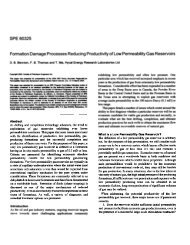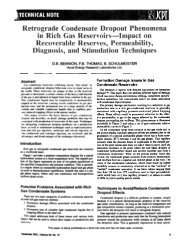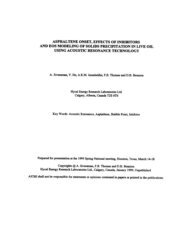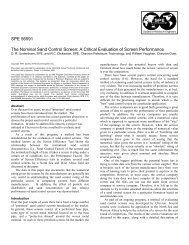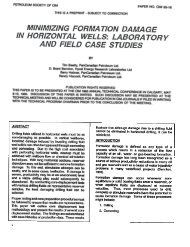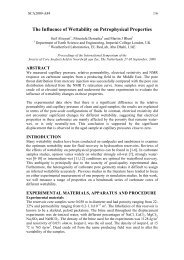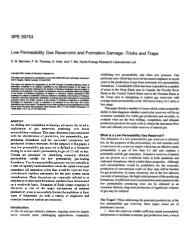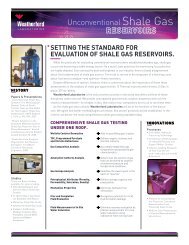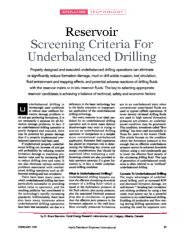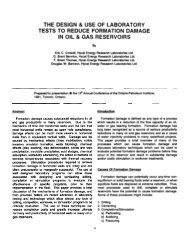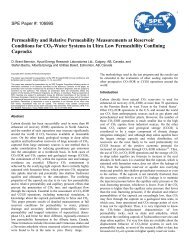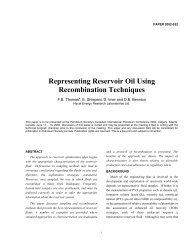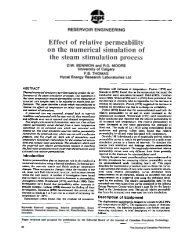Brine Imbibition Damage - Weatherford Laboratories
Brine Imbibition Damage - Weatherford Laboratories
Brine Imbibition Damage - Weatherford Laboratories
You also want an ePaper? Increase the reach of your titles
YUMPU automatically turns print PDFs into web optimized ePapers that Google loves.
SPE 84320<br />
<strong>Brine</strong> <strong>Imbibition</strong> <strong>Damage</strong> in the Colville River Field, Alaska<br />
M.D. Erwin, C.R. Pierson, SPE, ConocoPhillips Alaska Inc.; and D.B. Bennion, SPE, Hycal Energy Research<br />
<strong>Laboratories</strong>, Ltd<br />
Copyright 2003, Society of Petroleum Engineers Inc.<br />
This paper was prepared for presentation at the 2003 SPE Annual Technical Conference and<br />
Exhibition, October 5-8, 2003, Denver, Colorado.<br />
This paper was selected for presentation by an SPE Program Committee following review of<br />
information contained in an abstract submitted by the author(s). Contents of the paper, as<br />
presented, have not been reviewed by the Society of Petroleum Engineers and are subject to<br />
correction by the author(s). The material, as presented, does not necessarily reflect any<br />
position of the Society of Petroleum Engineers, its officers, or members. Papers presented at<br />
SPE meetings are subject to publication review by Editorial Committees of the Society of<br />
Petroleum Engineers. Electronic reproduction, distribution, or storage of any part of this paper<br />
for commercial purposes without the written consent of the Society of Petroleum Engineers is<br />
prohibited. Permission to reproduce in print is restricted to an abstract of not more than 300<br />
words; illustrations may not be copied. The abstract must contain conspicuous<br />
acknowledgment of where and by whom the paper was presented. Write Librarian, SPE, P.O.<br />
Box 833836, Richardson, TX 75083-3836, U.S.A., fax 01-972-952-9435.<br />
Abstract<br />
Early exploration well tests in the Colville River Field (also<br />
known as Alpine) drilled with water-based mud systems<br />
exhibited unexplainably high near-wellbore residual skin<br />
damage documented by pressure build-up testing. Typical<br />
formation damage mechanisms including clay reactions,<br />
mechanical damage, and gas trapping could not explain the<br />
damage.<br />
Between March 1998 and July 2001, laboratory testing<br />
determined imbibition-induced water trapping to be the<br />
primary formation damage mechanism. Insitu water saturation<br />
is significantly lower than the residual or connate water<br />
saturation, a condition rarely encountered in the field. Lab<br />
tests quantified impacts and identified methods to minimize or<br />
eliminate formation damage. This paper documents how<br />
successful identification of a unique damage mechanism<br />
improved drilling results in a low permeability sandstone.<br />
Introduction<br />
Exploration drilling results in Colville River prospects<br />
consistently demonstrated higher than expected near wellbore<br />
skin damage measured by build-up test analysis. Investigations<br />
into more common damage mechanisms such as solids<br />
migration and clay swelling could not explain the damage.<br />
Early reservoir core studies indicated residual water<br />
saturations from relative permeability curves should be higher<br />
than observed initial water saturations. Later studies with<br />
traced core fluids confirmed initial water saturations were<br />
considerably less than natural connate water saturations.<br />
Further lab work confirmed the water-blocking tendency by<br />
measuring water imbibition and permeability recovery during<br />
regain permeability tests. Various drilling fluids were tested,<br />
with oil muds consistently delivering higher regained<br />
permeability than water-based fluids.<br />
For a number of operational reasons, all wells on the first<br />
development pad (CD1) were drilled with brine-based fluids.<br />
The second pad (CD2) development team accepted the lab<br />
results and after demonstrating the potential benefits of oilbased<br />
mud drilling, convinced the Drilling team to develop<br />
and test a suitable mud program. Initial test results confirmed<br />
the lab results and conclusions when well CD2-47 came in<br />
flowing 300% more than predicted, based on equivalent brinebased<br />
mud completions in comparable pay. Following this<br />
early success, the oil mud program was expanded and has<br />
consistently delivered more productive wells in line with<br />
expectations from the lab work.<br />
Background. The Colville River Field (also known as the<br />
Alpine Field) is located approximately 60 miles due west of<br />
the Prudhoe Bay Field on the north slope of Alaska (see<br />
Figure 1).<br />
It contains 429 MMSTB of recoverable reserves, with<br />
approximately 1 billion barrels of oil-in-place. Production is<br />
from the Alpine Oil Pool, a very fine-grained Jurassic age<br />
shallow marine sandstone complex with stratigraphically<br />
trapped 40° API oil. The reservoir is normally pressured and<br />
undersaturated. Initial reservoir pressure is approximately 800<br />
psia above the bubble point, and primary recovery mechanism<br />
is solution drive. Tables 1 and 2 (below) present a log and<br />
petrophysical overview as well as a summary of key reservoir<br />
properties.<br />
The field was discovered in 1994 with drilling of the<br />
Bergschrund No. 1. Further delineation confirmed the prospect<br />
during subsequent winter seasons, and gravel pad construction<br />
began during the 1998 winter season. Field construction for<br />
the processing facilities and pipeline infrastructure<br />
commenced in the winter of 1999, followed closely by<br />
development drilling in May, 1999. The major process<br />
modules arrived in March of 2000, and first-oil was delivered<br />
in November.
2 M.D. ERWIN, C.R. PIERSON AND D.B. BENNION SPE 84320<br />
The development strategy utilizes horizontal completions<br />
in a direct line drive configuration while maximizing recovery<br />
through application of pattern waterflood and miscible-wateralternating-gas<br />
(MWAG) injection.<br />
Early Exploration Results. Following the early success of<br />
the Bergschrund No. 1 discovery well in 1994, additional<br />
wells were drilled during the winters of 1995 and 1996 to<br />
further delineate the reservoir and define reservoir properties<br />
to predict production performance. Geologic cores were<br />
collected from the two earliest cored wells, the Neve 1 and<br />
Alpine 1A. Bottomhole fluid samples were collected and<br />
analyzed. Due to the brief Arctic winter exploration season,<br />
only select wells were production tested. Upon completion of<br />
a production test, a pressure build-up test (PBU) was<br />
conducted to observe the pressure build-up response of the<br />
reservoir. Early well results indicated higher levels of<br />
formation damage than routinely observed in North Slope<br />
wells. The Table 2 lists the results from early well testing.<br />
Flow Efficiency, F, is calculated from:<br />
F<br />
−<br />
P − P<br />
=<br />
−<br />
wf<br />
P − P<br />
− ∆P<br />
Skin as it is used here is Total Skin, including all the<br />
geometric, partial penetration, perforation, and other impacts.<br />
These early wells were essentially vertical completions drilled<br />
with a balanced brine-based LSND (low solids non-dispersed)<br />
water-based mud program, perforated over the entire reservoir<br />
cross-section. Overbalanced perforating alone could not<br />
explain the consistently high mechanical skins. The LSND<br />
mud program used had been widely accepted in similar<br />
sandstone formations across the North Slope, and contained<br />
sufficient potassium chloride to inhibit anticipated clay<br />
reactions.<br />
When the project shifted from the Exploration to<br />
Production Team, completion engineers focused on this<br />
problem. Reservoir permeabilities ranging from 2 to 100 mD,<br />
averaging 15 mD, meant managing completion skins through<br />
controllable drilling and completion practices was inadequate.<br />
Areas for concern included:<br />
1. Higher rates improve wellhead flowing temperatures and<br />
reduce wax buildup. Early crude samples confirmed the<br />
40º API crude to be paraffinitic.<br />
2. Higher rates would minimize artificial lift requirements.<br />
3. Formation damage in the pores of low permeability rock<br />
is inherently difficult to remove.<br />
4. Formation damage mitigation in openhole horizontal<br />
wells is extremely difficult.<br />
5. Formation damage to injection wells limits waterflood<br />
injection rates which ultimately dictates production rates.<br />
6. Higher rates were needed to support project economics.<br />
7. Higher rates enhance ultimate recovery.<br />
wf<br />
s<br />
General Reservoir Description. The Alpine reservoir is<br />
characterized by a series of mature, well sorted, shallow<br />
marine sandstone deposits at approximately 7,000’ TVDSS on<br />
Alaska’s North Slope 1 . A type log is presented as Figure 2.<br />
The primary target is the Alpine “C” Sand, which is composed<br />
of two facies. The Stillstand facies is a very fine grained<br />
quartzose sandstone containing
SPE 84320 BRINE IMBIBITION DAMAGE IN THE COLVILLE RIVER FIELD, ALASKA 3<br />
quartz-rich sandstone containing relatively minor amounts of<br />
clay minerals. In general, Stillstand sections contain a higher<br />
clay content ranging from 3-8%, with 30-50% of the clays<br />
being potentially reactive mixed layer illite-smectite. The<br />
higher permeability Transgressive sections generally contain<br />
1-5% clays, with again almost 50% reactive mixed layer illitesmectite.<br />
Clays in general are well disbursed in both facies,<br />
but more so in the Transgressive. Neither contain significant<br />
quantities of clays, and the clays are too dispersed to impact<br />
the structural integrity of the matrix.<br />
Lab studies conducted both at the company research center<br />
and outside labs concluded that a completion fluid brine of<br />
>4% potassium chloride would be reasonably inhibited, and<br />
no significant permeability reductions were observed resulting<br />
from clay reactions and swelling in lab studies. Corollary<br />
studies concluded that seawater proposed for the waterflood is<br />
similarly non-reactive. However, fresh water triggers clay<br />
reactions, which result in permeability reductions in areas of<br />
filtrate invasion. Additionally, the use of caustic or other high<br />
pH (10+) fluids results in the deflocculation of clays,<br />
particularly kaolinite, which exists in limited concentrations in<br />
the pore system. Migration of mobilized fines results in pore<br />
throat plugging. Fines generally tend to migrate in the wetting<br />
phase, which for the tight microporous clays in a mixed<br />
wetting system, tends to be water. Expectations are that oilbased<br />
drilling and completion fluids would minimize problems<br />
related to either clay floculation or mobilization. In summary,<br />
lab analysis indicated application of appropriately inhibited<br />
brines minimizes filtrate leak-off impacts on sensitive clays.<br />
Mechanical damage refers to the invasion of extraneous<br />
solid material from drilling, completion, or kill fluids into the<br />
near wellbore region of the formation. The most common<br />
damage source for Alpine drilling operations would occur with<br />
overbalanced drilling operations, cement slurries, and filtrates<br />
in the final well completion. Typical solids associated with<br />
LSND drilling muds include natural formation solids and<br />
microfines generated by the milling action of PDC bits, and<br />
mud additives such as barite, bentonite, calcium carbonate<br />
bridging agents, or LCM materials. However, considering the<br />
relatively homogenous nature of the Alpine sandstones,<br />
relatively low permeability, small pore throat and grain sizes,<br />
and low overbalance pressures utilized during drilling, deep<br />
formation damage is not expected. The formation acts as a<br />
filter element capturing solids on the surface of the formation<br />
face. Solids invasion doesn’t penetrate deeper than 1/8” – 1/4”<br />
into the formation. Normal perforating charges should<br />
penetrate well beyond any expected radius of invasion. Since<br />
the exploration wells were cased, cemented, and perforated<br />
completions, it is unlikely that the high apparent skin factors<br />
observed on these wells can be attributed to near wellbore<br />
formation damage.<br />
<strong>Imbibition</strong> Concerns. Analysis of Alpine reservoir<br />
petrophysical data indicates very low apparent insitu water<br />
saturations relative to the permeability range. Core tests from<br />
four different wells indicate average water saturations are<br />
significantly below 30% at effective air permeability’s of 1md.<br />
Even at higher reservoir permeability ranges, such as 10-<br />
50md, water saturations remain below 20%. These initial<br />
saturations are considered sub-irreducible for the permeability<br />
ranges common in the Alpine sands. For example, a<br />
conventional capillary pressure test desaturated at the average<br />
column height of the Alpine reservoir would tend to indicate a<br />
much higher irreducible water saturation. Water-oil relative<br />
permeability tests based on Alpine core indicate the<br />
irreducible water saturations from normal capillary<br />
desaturation should be in the 40-50% range. The establishment<br />
of low initial water saturation may be due to a very significant<br />
height above free water contact or possibly the mixed oil-wet<br />
nature of the Alpine matrix. Therefore, the Alpine sands<br />
exhibit a potential hydrophilic tendency to spontaneously<br />
imbibe, or under forced displacement conditions, retain<br />
potentially significant water saturations.<br />
Water mobility is virtually zero below saturations of 40-<br />
50%. Although this creates favorable waterflood performance<br />
it’s also indicative of potential phase trapping problems with<br />
water-based drilling fluids. Therefore if water-based drilling or<br />
completion fluid were displaced into the formation, capillary<br />
forces would dominate making it virtually impossible to<br />
reduce near wellbore saturations below 40-50%. As seen in the<br />
oil-water imbibition relative permeability curves above, the<br />
resulting increase in near wellbore water saturation could<br />
easily reduce the effective permeability to oil by 80-90%. This<br />
damage mechanism appears to be consistent with the apparent<br />
high skin factors observed in the early exploration wells. Early<br />
examination of induction log results identified numerous<br />
examples of noticeable separation between the shallow and<br />
deep induction profiles, indicating invasion and retention of<br />
fluids in the near wellbore region 3-8 .<br />
Additionally, water-based polymers present in drilling or<br />
completion fluids may result in physical adsorption of polymer<br />
on the rock face. There may be a propensity for Alpine oil to<br />
emulsify with certain water-based completion fluids.<br />
Downhole precipitation of paraffin’s or asphaltenes, or<br />
mechanical glazing of the formation face due to rotating or<br />
sliding the drilling string may be damaging the Alpine<br />
formation. However, in comparison to the potential damage<br />
from imbibition, it appears unlikely these would be major<br />
damage mechanisms.<br />
Laboratory Test Results. Figure 5 provides an illustration of<br />
the coreflood apparatus that was used to conduct the Alpine<br />
reservoir coreflood studies. This apparatus was configured to<br />
allow dynamic drilling mud studies, where whole mud<br />
containing natural and artificial solids can be circulated at a<br />
desired overbalance pressure with fluid leakoff monitored, and<br />
the effect of drilling fluid invasion on oil permeability at<br />
various drawdown pressures. The equipment is also<br />
configured to allow underbalanced circulation of water-based<br />
fluids at varying underbalance pressure levels while constantly<br />
measuring the permeability to oil as water contacts the<br />
‘wellbore’ face of the sample to observe capillary pressure
4 M.D. ERWIN, C.R. PIERSON AND D.B. BENNION SPE 84320<br />
induced water-based fluid countercurrent imbibition effects.<br />
Table 3 summarizes the results from three countercurrent<br />
imbibition and water-based phase trap tests conducted on<br />
preserved core material obtained from well CD1-01. Sample<br />
1-1B represents high quality Stillstand, sample 2-1B<br />
represents lower quality Stillstand and sample 3-1B represents<br />
low quality Transgressive sand facies. Examination of the data<br />
indicates that permeability to oil rapidly dropped due to<br />
countercurrent imbibition effects as water was exposed to the<br />
production face, even when an applied delta P gradient of 100<br />
psi to oil was present flowing in the opposite direction. This<br />
indicates that the subnormal water saturation condition,<br />
coupled with the mixed wettability of the Alpine matrix,<br />
creates the potential for a strong capillary imbibition gradient<br />
which can create significant transient permeability reductions.<br />
Table 4 provides transient imbibition data for one core sample<br />
(1-1B). This data has been plotted and appears as Figure 6 and<br />
illustrates the rapid and severe reductions in oil phase<br />
permeability created by even moderately underbalanced water<br />
contact in the various Alpine facies.<br />
Table 3 indicates that, as the level of underbalance pressure<br />
is reduced, the force counteracting the water phase imbibition<br />
also is reduced and the amount of water imbibed increases<br />
further reducing the permeability to oil. In two of the samples,<br />
at the lower underbalance pressures, sufficient water was<br />
countercurrently imbibed to exceed the water-oil capillary<br />
pressure threshold for the system creating a 100% reduction in<br />
oil phase permeability. Table 3 also indicates the application<br />
of moderate drawdown pressures using pure oil (with free<br />
water contact eliminated from the core face) was capable of<br />
regaining a portion (50-60% in general) of the lost<br />
permeability. Some residual damage was present due to<br />
permanent entrapment of imbibed water in the core matrix by<br />
capillary pressure effects. To simulate a worst case situation<br />
with overbalanced water-based mud filtrate invasion, several<br />
pore volumes of water-based mud filtrate were then<br />
dynamically displaced through the three core samples<br />
simulating a filtrate flushed region adjacent to the wellbore.<br />
This was followed by another series of return permeability<br />
measurements to oil (Table 3) to note the effect of total waterbased<br />
filtrate flushing of the core matrix. It can be seen that<br />
the damage caused by water-based phase trapping was severe,<br />
with only 10-30% of the original oil phase permeability<br />
regained even after application of drawdown pressures as high<br />
as 500 psi. The increased damage is due to more thorough and<br />
deeper invasion of the core plug sample by direct water-based<br />
fluid flush in comparison to the limited invasion occurring<br />
over a relatively short time period in the countercurrent<br />
imbibition tests. Results indicate that even in an<br />
underbalanced condition, after extended periods of exposure to<br />
water, countercurrent induced damage could become very<br />
severe in the near wellbore region and may approach in<br />
magnitude those observed with direct fluid flushing which<br />
occurs during normal overbalanced drilling operations. The<br />
initial, 100 psi imbibition level, post imbibition regain perm<br />
and post overbalanced flush perms for the three samples are<br />
comparatively illustrated in Figure 7.<br />
Table 5 illustrates the results of a series of whole drilling<br />
fluid leakoff tests conducted on better quality Stillstand<br />
formation core from well CD1-01. Table 5 includes both the<br />
classic water-based drilling mud originally used in the field as<br />
well as the new oil-based system which, since base oil is<br />
miscible and compatible with the Alpine formation crude oil,<br />
exhibits no phase trap potential. The difference in regain<br />
permeability character due to the reduction in phase trap<br />
potential and easier filter cake lift-off is dramatically apparent<br />
in this data and has been reflected in associated field<br />
performance of the Alpine completions since this work was<br />
conducted. The permeability data summarized in Table 5 have<br />
been plotted and appear as Figure 8.<br />
Field Results. After completion of each producing well, the<br />
extent of near-wellbore damage was assessed by modeling<br />
inflow performance and wellbore hydraulics from stabilized<br />
well tests. A total skin value was determined from model<br />
matches of actual performance to quantify the level of damage<br />
in the well.<br />
The openhole segments of development wells at CD1 were<br />
drilled and completed utilizing a drill-in mud consisting of a<br />
clarified zanthan biopolymer system in a KCl base brine. Total<br />
skin values for the wells drilled with brine muds ranged from<br />
5 to 40, with an average of 23. Consistent with lab results, a<br />
high level of damage was observed in the wells and attributed<br />
to water retention in the near-wellbore region. Differences in<br />
rock quality appear to explain the spectrum of damage in the<br />
wells. Wells with lower skin values are generally observed in<br />
high permeability rock as shown by a sample of 10 CD1 wells<br />
drilled with brine-based mud in Figure 9. In this scenario,<br />
invaded water is more readily flushed from the near-wellbore<br />
region in the higher permeability rock due to lower capillary<br />
pressure based retention effects, thus mitigating the water<br />
block damage. In very early well tests, limited free water<br />
production is observed as new wells clean up, which further<br />
confirms the expulsion of filtrate fluids.<br />
In contrast, wells completed in lower permeability rock<br />
display consistently higher skin values as shown in Figure 9.<br />
Reduced deliverability results in substantially longer cleanup<br />
periods. A review of well test history shows slight water<br />
production for 5-8 months as invaded water is slowly<br />
recovered from the near-wellbore region in some wells. As<br />
observed in lab studies, low permeability wells with higher<br />
relative microporosity exhibit higher capillary attraction for<br />
brine, and retain it under higher drawdown pressures.<br />
Unfortunately, the associated deliverability further reduces the<br />
formations ability to recover from brine invasion.<br />
Six producers were drilled and completed at CD2 with<br />
brine-based polymer drill-in fluids. <strong>Damage</strong> levels in these<br />
wells were comparable to the damage levels observed at CD1.<br />
This was of particular concern since CD2 wells are generally<br />
lower permeability. Inflow performance modeling quantified<br />
the production increases expected, based on lab results with<br />
oil-based drill-in fluids. As shown in Figure 10, two inflow
SPE 84320 BRINE IMBIBITION DAMAGE IN THE COLVILLE RIVER FIELD, ALASKA 5<br />
performance curves are described at bottomhole conditions.<br />
Assuming the well is produced at a manifold pressure of 225<br />
psig, an AOF of 1,972 BOPD is achieved with a skin of 23,<br />
the average total skin for water-based wells drilled to date. An<br />
oil mud drilled well with a skin of 8, or 66% less damage than<br />
an average brine mud drilled well, was also modeled and<br />
shown in Figure 10. With this reduction, an AOF of 3,293<br />
BOPD is attained, an increase of 67%. For that reason the<br />
development team introduced oil-based drilling fluids in the<br />
CD2 program. To date, 10 producing wells have been drilled<br />
and completed with oil mud at CD2. Current well performance<br />
demonstrates an overall total skin reduction in oil-mud (OBM)<br />
wells relative to the water-based mud (WBM) wells of 3.5:1.<br />
To further illustrate the benefit of OBM, two wells were<br />
highlighted from CD2. Wells A, B, and C were completed<br />
with WBM while Well D was completed with OBM.<br />
Comparing Wells C and D geologically, both wells were<br />
completed in comparable Stillstand facies sections with<br />
approximately the same thickness (150 ft) and horizontal<br />
length (3,505 ft vs. 3,704 ft). From core taken in the offset<br />
exploration well, Neve #1, the average reservoir permeability<br />
in this area is approximately 6.5 mD. As shown in Table 6,<br />
Well D returned twice the productivity and tested oil<br />
deliverability. Appropriately Well D’s skin is approximately<br />
one-third of Well C, further validating lab results via tested<br />
field results.<br />
Unlike wells completed with brine-based drill-in fluids in<br />
low permeability intervals, water production has not been<br />
observed in Well D or other oil mud drilled wells.<br />
Conclusions<br />
The use of oil-based drilling fluids in the Alpine formation of<br />
the Colville River Field has successfully mitigated the waterbased<br />
imbibition damage identified in the laboratory. This<br />
unique formation damage mechanism stemming from drilling<br />
in rock with water saturations below normal connate levels is<br />
not commonly observed in the field. The following<br />
conclusions can be noted:<br />
1. Careful analysis of early core and reservoir properties can<br />
lead to the successful identification of damage<br />
mechanisms.<br />
2. Sub-critical water saturations (in-situ saturation below<br />
connate levels) have been observed in Alaska North Slope<br />
sandstones.<br />
3. Careful selection of drill-in fluids leads to improved<br />
completion performance.<br />
4. Waterflood breakthrough can be expected to reduce<br />
wellbore relative permeability as near wellbore formation<br />
water saturation increases.<br />
Remedial treatments which successfully remove near<br />
wellbore bound water can be expected to improve<br />
performance of early wells drilled with brine-based muds.<br />
Alvord for recognizing the potential and clearing the many<br />
obstacles that brought the lab work into the field.<br />
The interpretations and conclusions presented in this paper<br />
are those of the authors and do not necessarily reflect the<br />
opinions of ConocoPhillips Alaska, Inc. or its copartners in<br />
joint ventures.<br />
References<br />
1. Gingrich, Dean, Knock, Doug and Masters, Ron 2001<br />
“Geophysical interpretation methods applied at Alpine Oil Field:<br />
North Slope, Alaska” 2000 SEG Leading Edge Magazine, July<br />
2001.<br />
2. Hannon and Gingrich 2000 “The Discovery of a new Alaskan<br />
reservoir: The Alpine Field, North Slope, Alaska-USA” AAPG<br />
2000 Abstracts.<br />
3. Bennion, D. Brant, Bietz, Ronald F., Thomas, F. Brent<br />
“Reductions in the Productivity of Oil & Gas Reservoirs Due to<br />
Aqueous Phase Trapping”, The Petroleum Society of CIM #93-<br />
24, presented at the May 1993 CIM Annual Technical<br />
Convention.<br />
4. Bennion, D. Brant, Bietz, Ronald F., Thomas, F. Brent, Bennion,<br />
Douglas.W., “Water and Hydrocarbon Phase Trapping in Porous<br />
Media – Diagnosis, Prevention and Treatment”, The Petroleum<br />
Society of CIM #95-69, presented at the May 1995 CIM Annual<br />
Technical Convention.<br />
5. Bennion, D. Brant, Thomas, F. Brent, Bietz, Ronald F.,<br />
“Formation <strong>Damage</strong> and Horizontal Wells – A Productivity<br />
Killer”, SPE #37138, presented at the November 1996<br />
Horizontal Well Technology Conference in Calgary.<br />
6. Bennion, D. Brant, Thomas, F. Brent, Bennion, Douglas.W.,<br />
Bietz, Ronald F., “Fluid Design to Minimize Invasive <strong>Damage</strong><br />
in Horizontal Wells”, The Petroleum Society of CIM #94-71,<br />
presented at the March 1994 CIM Conference on Recent<br />
Advances in Horizontal Well Applications.<br />
7. Gruber, N.G., “Water Block Effects in Low Permeability Gas<br />
Reservoirs”, The Petroleum Society of CIM #96-92, presented at<br />
the June 1996 CIM Annual Technical Convention.<br />
8. Akin, S., Kovscek, A.R. , “<strong>Imbibition</strong> Studies on Low-<br />
Permeability Porous Media”, Society of Petroleum Engineers<br />
#54590, presented at the May 1999 Western Regional Meeting<br />
in Anchorage.<br />
9. Erwin, M.D., Redman, R.S., Sanders, L. Allan, “Multiwell<br />
Interference Test in the Colville River Field, Alaska”, SPE<br />
#77453, presented at the October 2002 Annual Technical<br />
Conference.<br />
Acknowledgments<br />
We thank ConocoPhillips Alaska Inc. and Anadarko’s Alpine<br />
development teams. Special thanks to C.L. Crabtree and G.L.
Table 1. Alpine Reservoir Average Parameters<br />
Recovery, MBO<br />
OOIP, MMBO<br />
Area, acres<br />
Depth, fee Subsea<br />
Average Net Pay, feet<br />
Average Porosity, %<br />
Average Oil Saturation, %<br />
Average Permeability, md<br />
Oil Gravity, API°<br />
Initial Reservoir Pressure, psi<br />
Bubble Point Pressure, psi<br />
429<br />
1,000<br />
40,000<br />
7,000<br />
50<br />
19<br />
80<br />
15<br />
40<br />
3215<br />
2454<br />
Table 2. Alpine Initial Well Test <strong>Damage</strong> Analysis<br />
(Drilled Using Water-Based Mud<br />
Well<br />
I.D.<br />
Permeability<br />
mD<br />
Total<br />
Skin<br />
1 56.4 10.6 40.3%<br />
2 4.5 16.9 30.9%<br />
3 6.6 28.9 17.0%<br />
Flow Efficiency<br />
%<br />
Table 3 – Water Spontaneous <strong>Imbibition</strong>/Phase Trap Test Results<br />
for Various Alpine Reservoir Rock Facies<br />
(Using Solids Free Water-based Mud Filtrate)<br />
Rock Sample Baseline Oil Perm During <strong>Imbibition</strong> Post <strong>Imbibition</strong> Drawdown Post-OB Drawdown<br />
Type No. Oil Perm ∆P<br />
Perm<br />
Pulse Perm<br />
100 psi 100 psi 30 psi 5 psi @ Drawdown @ Drawdown<br />
(mD) (mD) (mD) (mD) (mD) (psi) (mD) (psi)<br />
1 1-1B 1.831 0.211 0.000 0.000 0.766 500 0.278 500<br />
2 2-1B 1.887 0.673 0.000 0.000 0.908 100 0.621 100<br />
3 3-1B 1.601 0.692 0.415 0.395 1.186 100 0.178 500<br />
Table 4: Illustration of Pressure/Time Dependant Countercurrent<br />
<strong>Imbibition</strong> Effects for a Typical Alpine Core Sample<br />
Core No. 1-1B Rock Type 1<br />
Depth (ft) 7118-7119 Porosity (%) 21<br />
Cuml Time<br />
<strong>Imbibition</strong> Phase<br />
100 psi 30 psi 5 psi<br />
Oil Flow Oil<br />
Oil Cuml Oil Flow<br />
Rate Perm Cuml Time Oil Flow Rate Perm Time Rate<br />
Oil Perm<br />
(min) (cc/min) (mD) (min) (cc/min) (mD) (min) (cc/min) (mD)<br />
26 19 1.784 10 0.20 0.063 10 0.00 0.000<br />
87 8.85 0.831 30 0.00 0.000 30 0.00 0.000<br />
135 3.75 0.352 60 0.00 0.000 60 0.00 0.000<br />
246 2.7 0.254 90 0.00 0.000 90 0.00 0.000<br />
288 2.40 0.225 120 0.00 0.000 120 0.00 0.000<br />
382 2.30 0.216 180 0.00 0.000 180 0.00 0.000<br />
552 2.25 0.211 240 0.00 0.000 240 0.00 0.000<br />
644 2.25 0.211 300 0.00 0.000 300 0.00 0.000
SPE 84320 BRINE IMBIBITION DAMAGE IN THE COLVILLE RIVER FIELD, ALASKA 7<br />
Table 5: Comparative Whole Water and Oil-based<br />
Drilling Fluid Performance in Alpine Stillstand Facies Sandstones<br />
Sample Depth Mud Initial Oil Perm (mD)<br />
Fluid Leakoff During<br />
Mud Exposure Post Mud Oil Perm (mD)<br />
% Reduction in<br />
Oil Perm<br />
I.D. Ft Type 5 psi DD 100 psi DD cc 5 psi DD 100 psi DD 100 psi DD<br />
2B-4 7112.8 H20 Base 6.69 4.57 1.4 0 0.45 -88.7<br />
2B-3 7112.7 H2O Base 3.76 3.73 1.9 0 0.8 -78.6<br />
2B-1 7112.5 Oil Base 5.69 5.05 0 3.08 5.04 -0.6<br />
2B-2 7112.6 Oil Base 1.65 1.81 0 1.6 1.8 -3.5<br />
Note: Exposure period consists of mud at 500 psi overbalance and 14-day shut-in under mud.<br />
Table 6: Alpine Well Flow Properties: OBM vs WBM<br />
Well Mud Qo FTP Perm PI Skin<br />
(BOPD) (psig) (mD) (STB/D/PSI)<br />
A WBM 4,950 292 24.5 4.9 13<br />
B WBM 3,006 215 17.7 1.5 33<br />
C WBM 1,694 234 6.6 1.0 22<br />
D OBM 3,256 293 6.4 1.9 8
8 M.D. ERWIN, C.R. PIERSON AND D.B. BENNION SPE 84320<br />
Figure 1: Alpine Area Field Locations<br />
Figure 2: Alpine Type Log
SPE 84320 BRINE IMBIBITION DAMAGE IN THE COLVILLE RIVER FIELD, ALASKA 9<br />
Figure 3: Alpine Stillstand Formation Oil-Water Relative Permeability Curves<br />
Stillstand Water-Oil <strong>Imbibition</strong><br />
1.0<br />
Relative Permeability<br />
0.9<br />
0.8<br />
0.7<br />
0.6<br />
0.5<br />
0.4<br />
0.3<br />
0.2<br />
0.1<br />
0.0<br />
KRWO<br />
KROW<br />
0 0.1 0.2 0.3 0.4 0.5 0.6 0.7 0.8 0.9 1<br />
Sw (fraction)<br />
Figure 4: Alpine Stillstand Formation Transgressive Water-Oil Relative Permeability Curves<br />
Transgressive Water-Oil <strong>Imbibition</strong><br />
Relative Permeability<br />
1<br />
0.9<br />
0.8<br />
0.7<br />
0.6<br />
0.5<br />
KRWO<br />
0.4<br />
KROW<br />
0.3<br />
0.2<br />
0.1<br />
0<br />
0 0.1 0.2 0.3 0.4 0.5 0.6 0.7 0.8 0.9 1<br />
Sw (fraction)
10 M.D. ERWIN, C.R. PIERSON AND D.B. BENNION SPE 84320<br />
Figure 5 – Alpine Whole Mud Leakoff and Countercurrent <strong>Imbibition</strong> Apparatus<br />
OVEN<br />
Hydrocarbon<br />
Injection<br />
Piston<br />
Sample Injection<br />
Piston<br />
Coreholder<br />
Pump<br />
Pressure<br />
Source<br />
Extraction<br />
System<br />
Pressure<br />
Transducer<br />
Production<br />
Production<br />
Production<br />
Pump<br />
To Annulus Pump<br />
Figure 6 – Sample 1-1B Illustration of Water Countercurrent<br />
<strong>Imbibition</strong> Effects on Permeability to Oil at 100 psi Drawdown Level<br />
Effective Oil Permeability vs. Exposure Time at<br />
100 psi Underbalance Pressure Level<br />
Oil Permeability - mD<br />
2<br />
1.8<br />
1.6<br />
1.4<br />
1.2<br />
1<br />
0.8<br />
0.6<br />
0.4<br />
0.2<br />
0<br />
0 100 200 300 400 500 600 700<br />
Exposure Time - Minutes
SPE 84320 BRINE IMBIBITION DAMAGE IN THE COLVILLE RIVER FIELD, ALASKA 11<br />
Figure 7 – Comparison of Alpine Water-Based<br />
Countercurrent <strong>Imbibition</strong> and Phase Trap Test Results<br />
Comparison of Water Based <strong>Imbibition</strong> and<br />
Phase Trap Tests<br />
Permeability to Oil - mF<br />
2<br />
1.8<br />
1.6<br />
1.4<br />
1.2<br />
1<br />
0.8<br />
0.6<br />
0.4<br />
0.2<br />
0<br />
Initial<br />
100 psi<br />
Imbibtion<br />
Phase<br />
Post <strong>Imbibition</strong><br />
Pure Oil<br />
Post<br />
Overbalanced<br />
Flush<br />
Sample 1-1B<br />
Sample 2-1B<br />
Sample 3-1B<br />
Test Phase<br />
Figure 8 – Comparison of Alpine Stillstand Whole Water and<br />
Oil-Based Drilling Fluid Leakoff and Regain Permeability Tests<br />
Comparison of Alpine Whole Water and Oil Base<br />
Drilling Fluid Regain Perm Test Results<br />
6<br />
Permeability to Oil - mD<br />
5<br />
4<br />
3<br />
2<br />
1<br />
Initial Oil Perm<br />
Final Oil Perm<br />
0<br />
2B-4 WB 2B-3 WB 2B-1 OB 2B-2 OB<br />
Test Phase
12 M.D. ERWIN, C.R. PIERSON AND D.B. BENNION SPE 84320<br />
Figure 9: Alpine Water-Based Drilled Wells<br />
Permeability vs. Skin<br />
Skin<br />
45<br />
40<br />
35<br />
30<br />
25<br />
20<br />
15<br />
10<br />
5<br />
0<br />
15.0 20.0 25.0 30.0 35.0 40.0 45.0<br />
Permeability (mD)<br />
Figure 10 – Inflow Performance Relationships of OBM vs WBM<br />
A<br />
2<br />
1



